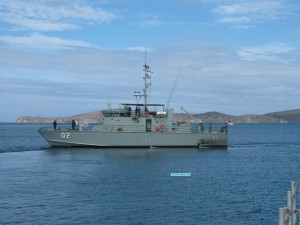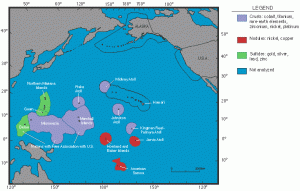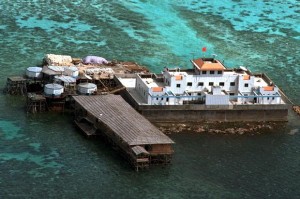 After screaming about our absence for years, it is great to see U.S. government leaders start to offer some attention to the front lines of the next Cold War, those fragile states of the “Deep Pacific”.
After screaming about our absence for years, it is great to see U.S. government leaders start to offer some attention to the front lines of the next Cold War, those fragile states of the “Deep Pacific”.
This Thursday’s visit to the Republic of the Marshall Islands by the SECNAV is primarily focused on an interesting renewable energy proposal for Kwajalein and the U.S. Army facility there. However, during a side-trip to Majuro, the SECNAV will visit the local Sea Patrol Surveillance Headquarters and get a better sense of the old-school maritime challenges facing the Marshalls–particularly as their 60-person Maritime Authority/Navy struggles to maintain control over a sprawling 2.1 million square mile EEZ.
I especially hope SECNAV gets a chance to physically review the Marshall Islands’ Navy. The review won’t take long, as the Marshall Islands’ armada consists of a single small patrol boat.
 The boat itself is a product of the 80’s era “Pacific Patrol Boat” program–an innovative Australian program that provided 12 Pacific nations 22 simple, standardized patrol craft. The goal of the program was to help countries in the Pacific basin establish better control of their territorial waters and their massive EEZs. The program hasn’t been perfect–it cost more than expected, and, well, at this point, many of the ships put to sea rarely, if at all.
The boat itself is a product of the 80’s era “Pacific Patrol Boat” program–an innovative Australian program that provided 12 Pacific nations 22 simple, standardized patrol craft. The goal of the program was to help countries in the Pacific basin establish better control of their territorial waters and their massive EEZs. The program hasn’t been perfect–it cost more than expected, and, well, at this point, many of the ships put to sea rarely, if at all.
Hopefully Australia’s new cost-cutting, foreign-aid slashing government is still committed, and Australia’s past frustrations with the program hasn’t sapped their far-sighted interest in helping the Pacific’s struggling island-based countries to better control their lawless maritime territory.
If that program is to continue, something will need to happen soon. As with the rest of the Pacific Patrol Boat fleet, the sole vessel of the Marshall Islands Navy is nearing the end of its service life. And if Australia is out, it would be great if–at least in the newly-strategic countries engaged in a Compact of Free Association with the United States–America could start setting the stage for offering a simple replacement craft, and help sketch out a route to growing these fledgling navies into a competent set of “forward-deployed” and friendly eyes-and-ears for the Deep Pacific.
 Aside from the demonstrable benefits the various countries will get by imposing better control over their seafloor and EEZ resources, America benefits from getting, essentially, budget forward presence–presence that can help track, monitor and confront emergent Chinese–or other country–forays into the Deep Pacific.
Aside from the demonstrable benefits the various countries will get by imposing better control over their seafloor and EEZ resources, America benefits from getting, essentially, budget forward presence–presence that can help track, monitor and confront emergent Chinese–or other country–forays into the Deep Pacific.
Look. We already know that China has few qualms about militarizing commercial vessels. And I will tell you now, as the Chinese Navy grows, no Chinese naval flotilla will travel into the Pacific without, oh, an attendant network of quasi-governmental fishing trawlers leading the way. So, with that in mind, it might be good (for everybody involved) to have a set of nominally non-US or US-friendly “Patrol Navies” helping to tend/monitor “interesting” non-commercial commercial vessels.
 As sea features become increasingly important for dictating territorial claims, economic benefit and power projection, seeding the Pacific with a set of active, trained “Patrol Navies” make a particularly worthwhile investment. The South China Sea has shown us all the strategic heartache that comes from a failure to monitor and control EEZ activities. Imagine if the Marshalls (or any other island/atoll-based nation) followed the Philippines example from the ’90s, and woke up one day to find that a set of Chinese “fishermen” had taken up residence and built a barracks on some of the country’s ten uninhabited atolls?
As sea features become increasingly important for dictating territorial claims, economic benefit and power projection, seeding the Pacific with a set of active, trained “Patrol Navies” make a particularly worthwhile investment. The South China Sea has shown us all the strategic heartache that comes from a failure to monitor and control EEZ activities. Imagine if the Marshalls (or any other island/atoll-based nation) followed the Philippines example from the ’90s, and woke up one day to find that a set of Chinese “fishermen” had taken up residence and built a barracks on some of the country’s ten uninhabited atolls?
Prevention of such encroachment is a whole lot easier than the cure.
Aside from the Pacific Patrol Boat Program, the first few hesitant steps towards establishing stronger law enforcement within the “Deep Pacific” are underway–in the Marshalls, the U.S. (with help from friends) is helping develop the local law enforcement’s maritime skill set, collaborating with the local Maritime Authority in ISR, training them, and having sailors/fisheries enforcement folks “ride along” when our Navy or Coast Guard ships patrol the area. Raising their Navy’s profile by having the SECNAV visit the Sea Patrol surveillance headquarters is a good thing.
But time is short. At a minimum, we need to translate the SECNAV’s interest into a wider national strategy and a concerted regional initiative. Some good, logical places to start would be in the Republic of the Marshall Islands, the Republic of Palau and the Federated States of Micronesia–all countries engaged in a Compact of Free Association with the United States. If these countries are going to be on the front lines of a new Cold War or the “poor bloody infantry” in an Asian race for sea-based resources, then let’s commit to give these countries the tools, training and guidance they need to help manage the security of their ocean in the years ahead.

{ 3 comments… read them below or add one }
Thanks for the note! Good point about how the folks engaged now may not understand the parameters. It ain’t the Cold War redux and the Pacific Basin ain’t Europe–It’s a lot more complex than many policymakers–and the public on both sides of the Ocean–are prepared to handle…
I enjoyed the article and I like “Strategic” better than “Cold War.” During the Cold War both sides understood the parameters.
I’m not sure the Chinese do, and I’m certain Barack Obama has not a clue or a care.
After some hand-wringing, I toned down the title, swapping out “Cold War” for “Strategic”….thought strategic was a bit more accurate. Thoughts?